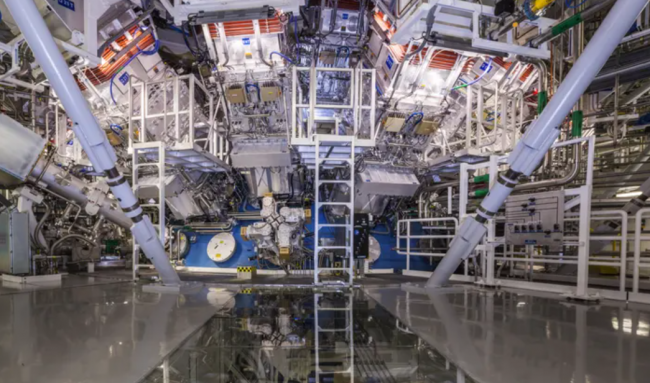Articles Menu

Website editor: A couple of notes:
Dec. 12, 2022
See video here: https://youtu.be/mN0ACGrZ_g0
Researchers have reportedly made a breakthrough in the quest to unlock a “near-limitless, safe, clean” source of energy: they have got more energy out of a nuclear fusion reaction than they put in.
Nuclear fusion involves smashing together light elements such as hydrogen to form heavier elements, releasing a huge burst of energy in the process. The approach, which gives rise to the heat and light of the sun and other stars, has been hailed as having huge potential as a sustainable, low-carbon energy source.
However, since nuclear fusion research began in the 1950s, researchers have been unable to a demonstrate a positive energy gain, a condition known as ignition.
That was, it seems, until now.
According to a report in the Financial Times, which has yet to be confirmed by the National Ignition Facility (NIF) at Lawrence Livermore National Laboratory in California that is behind the work, researchers have managed to release 2.5 MJ of energy after using just 2.1 MJ to heat the fuel with lasers.
Dr Robbie Scott, of the Science and Technology Facilities Council’s (STFC) Central Laser Facility (CLF) Plasma Physics Group, who contributed to this research, described the results as a “momentous achievement”.
“Fusion has the potential to provide a near-limitless, safe, clean, source of carbon-free baseload energy,” he said. “This seminal result from the National Ignition Facility is the first laboratory demonstration of fusion ‘energy-gain’ – where more fusion energy is output than input by the laser beams. The scale of the breakthrough for laser fusion research cannot be overstated.
“The experiment demonstrates unambiguously that the physics of Laser Fusion works,” he added. “In order to transform NIF’s result into power production a lot of work remains, but this is a key step along the path.”
Prof Jeremy Chittenden, professor of plasma physics at Imperial College London, agreed. “If what has been reported is true and more energy has been released than was used to produce the plasma, that is a true breakthrough moment which is tremendously exciting,” he said.
“It proves that the long sought-after goal, the ‘holy grail’ of fusion, can indeed be achieved.”
But experts have stressed that while the results would be an important proof of principle, the technology is a long way from being a mainstay of the energy landscape. To start with, 0.4MJ is about 0.1kWh – about enough energy to boil a kettle.
“To turn fusion into a power source we’ll need to boost the energy gain still further,” said Chittenden. “We’ll also need to find a way to reproduce the same effect much more frequently and much more cheaply before we can realistically turn this into a power plant.”
Prof Justin Wark, professor of physics at the University of Oxford, added that while, in principle, the Lawrence Livermore National Laboratory could produce such a result about once a day, a fusion power plant would need to do it 10 times a second.
However, Chittenden stressed the NIF was designed for a scientific demonstration, not as a power plant. “The efficiency of converting electrical energy to laser energy was not a factor in its design,” he said.
“The experiments on NIF demonstrate the scientific process of ignition and how this leads to high fusion energy gain, but to turn this into a power station we need to develop simpler methods to reach these conditions, which will need to be more efficient and above all cheaper in order for inertial fusion to be realised as a fusion power source.”
The latest results, if true, top the last big breakthrough by the facility which came just last year when it was announced that the team had hit 70% of the laser energy put in to the experiment released as nuclear energy.
[Top photo: 'Major scientific breakthrough': US recreates fusion]